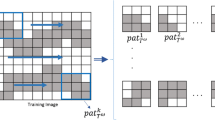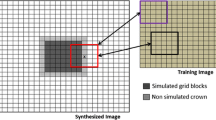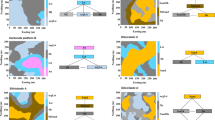Abstract
In recent years, multiple-point geostatistical (MPS) approaches have gained significant popularity for modeling subsurface heterogeneity in hydrogeological systems by employing a training image for describing the features of the target field. The most important challenges of MPS simulation methods include appropriate pattern reproduction and connectivity preservation, handling conditional data, and appropriately modeling the variability of real fields. Preserving connectivity of the patterns is of paramount importance, particularly in fluid flow modeling problems. During sequential simulation, if the algorithm produces a value (or patch) inconsistently with previously synthesized data, such conflicts will propagate in the realization and lead to poor pattern reproduction. Here, we have introduced a two-step simulation algorithm, where in the first phase, the coarse structure of the realization is synthesized with minimum conflicts by rejecting inconsistent patterns and allowing removing previously synthesized data, and in the second phase, the fine grid is simulated by ignoring the conflicts. Ignoring short-range inconsistencies in the fine simulation phase not only improves the algorithm’s convergence but also leads to higher variabilities without sacrificing the quality of the realizations. Convergence problems of traditional conflict-handling methods are further alleviated by a new distance reweighting strategy, which prevents cyclic deletions and resimulations. We have employed different statistical descriptors to evaluate our method in comparison with existing pixel and patch-based methods in conditional and unconditional modes. The proposed method shows outstanding results in terms of connectivity preservation, conditional data handling, and pattern innovation. Compared to traditional conflict-handling methods, the proposed method shows good convergence and histogram preservation.














Similar content being viewed by others
References
Abdollahifard MJ (2016) Fast multiple-point simulation using a data-driven path and an efficient gradient-based search. Comput Geosci 86:64–74
Abdollahifard MJ, Ahmadi S (2016) Reconstruction of binary geological images using analytical edge and object models. Comput Geosci 89:239–251
Abdollahifard MJ, Faez K (2014) Fast direct sampling for multiple-point stochastic simulation. Arab J Geosci 7(5):1927–1939
Abdollahifard MJ, Nasiri B (2017) Exploiting transformation-domain sparsity for fast query in multiple-point geostatistics. Comput Geosci 21(2):289–299
Abdollahifard MJ, Mariethoz G, Pourfard M (2016) Improving in situ data acquisition using training images and a Bayesian mixture model. Comput Geosci 91:49–63
Abdollahifard MJ, Baharvand M, Mariéthoz G (2019a) Efficient training image selection for multiple-point geostatistics via analysis of contours. Comput Geosci 128:41–50
Abdollahifard MJ, Mariethoz G, Ghavim M (2019b) Quantitative evaluation of multiple-point simulations using image segmentation and texture descriptors. Comput Geosci 23:1349
Abdollahifard, MJ, Mariéthoz G, Mohammadi HS (2020) Investigating extreme scenarios with multiple-point geostatistics and variance maximization. Stoch Environ Res Risk Assess 34:67–85. https://doi.org/10.1007/s00477-019-01759-y
Bayer P, Huggenberger P, Renard P, Comunian A (2011) Three-dimensional high resolution fluvio-glacial aquifer analog: Part 1: Field study. J Hydrol 405(1–2):1–9
Boucher A, Kyriakidis PC, Cronkite-Ratcliff C (2007) Geostatistical solutions for super-resolution land cover mapping. IEEE Trans Geosci Remote Sens 46(1):272–283
Caers J, Strebelle S, Payrazyan K (2003) Stochastic integration of seismic data and geologic scenarios: A West Africa submarine channel saga. Lead Edge 22(3):192–196
Chen Q, Liu G, Ma X, Zhang J, Zhang X (2019) Conditional multiple-point geostatistical simulation for unevenly distributed sample data. Stoch Environ Res Risk Assess 33:973–987. https://doi.org/10.1007/s00477-019-01671-5
Comunian A, Renard P, Straubhaar J, Bayer P (2011) Three-dimensional high resolution fluvio-glacial aquifer analog–Part 2: Geostatistical modeling. J Hydrol 405(1–2):10–23
Dagasan Y, Erten O, Renard P, Straubhaar J, Topal E (2019) Multiple-point statistical simulation of the ore boundaries for a lateritic bauxite deposit. Stoch Env Res Risk Assess 33(3):865–878
de Carvalho PRM, da Costa JFCL, Rasera LG, Varella LES (2017) Geostatistical facies simulation with geometric patterns of a petroleum reservoir. Stoch Environ Res Risk Assess 31(7):1805–1822
dell’Arciprete D, Bersezio R, Felletti F, Giudici M, Comunian A, Renard P (2012) Comparison of three geostatistical methods for hydrofacies simulation: a test on alluvial sediments. Hydrogeol J 20(2):299–311
Falivene O, Arbues P, Gardiner A, Pickup G, Munoz JA, Cabrera L (2006) Best practice stochastic facies modeling from a channel-fill turbidite sandstone analog (the Quarry outcrop, Eocene Ainsa basin, northeast Spain). AAPG bulletin 90(7):1003–1029
Guardiano FB, Srivastava RM (1993) Multivariate geostatistics: beyond bivariate moments Geostatistics Troia’92. Springer, Berlin, pp 133–144
He XL, Sonnenborg TO, Jørgensen F, Jensen KH (2014) The effect of training image and secondary data integration with multiple-point geostatistics in groundwater modelling. Hydrol Earth Syst Sci 18(8):2943–2954
Honarkhah M, Caers J (2010) Stochastic simulation of patterns using distance-based pattern modeling. Math Geosci 42(5):487–517
Huysmans M, Dassargues A (2009) Application of multiple-point geostatistics on modelling groundwater flow and transport in a cross-bedded aquifer (Belgium). Hydrogeol J 17(8):1901
Jha SK, Mariethoz G, Kelly BFJ (2013) Bathymetry fusion using multiple-point geostatistics: novelty and challenges in representing non-stationary bedforms. Environ Model Softw 50:66–76
Kalantari S, Abdollahifard MJ (2016) Optimization-based multiple-point geostatistics: a sparse way. Comput Geosci 95:85–98
Karimpouli S, Tahmasebi P (2016) Conditional reconstruction: An alternative strategy in digital rock physics. Geophysics 81(4):D465–D477
Le Coz M, Genthon P, Adler PM (2011) Multiple-point statistics for modeling facies heterogeneities in a porous medium: the Komadugu-Yobe alluvium, Lake Chad basin. Math Geosci 43(7):861
Li X, Mariethoz G, Lu D, Linde N (2016) Patch-based iterative conditional geostatistical simulation using graph cuts. Water Resour Res 52(8):6297–6320
Maharaja A (2008) TiGenerator: object-based training image generator. Comput Geosci 34(12):1753–1761
Mahmud K, Mariethoz G, Caers J, Tahmasebi P, Baker A (2014) Simulation of Earth textures by conditional image quilting. Water Resour Res 50(4):3088–3107
Mariethoz G, Caers J (2014) Multiple-point geostatistics: stochastic modeling with training images. Wiley, London
Mariethoz G, Renard P, Straubhaar J (2010) The direct sampling method to perform multiple-point geostatistical simulations. Water Resour Res 46:11
Mariethoz G, McCabe MF, Renard P (2012) Spatiotemporal reconstruction of gaps in multivariate fields using the direct sampling approach. Water Resour Res 48:10
Meerschman E, Pirot G, Mariethoz G, Straubhaar J, Van Meirvenne M, Renard P (2013) A practical guide to performing multiple-point statistical simulations with the direct sampling algorithm. Comput Geosci 52:307–324
Okabe H, Blunt MJ (2007) Pore space reconstruction of vuggy carbonates using microtomography and multiple-point statistics. Water Resour Res 43:12
Oriani F, Straubhaar J, Renard P, Mariethoz G (2014) Simulation of rainfall time series from different climatic regions using the direct sampling technique. Hydrol Earth Syst Sci 18:3015–3031
Pardo-Igúzquiza E, Dowd PA (2003) CONNEC3D: a computer program for connectivity analysis of 3D random set models. Comput Geosci 29(6):775–785
Pourfard M, Abdollahifard MJ, Faez K, Motamedi SA, Hosseinian T (2017) PCTO-SIM: Multiple-point geostatistical modeling using parallel conditional texture optimization. Comput Geosci 102:116–138
Renard P, Allard D (2013) Connectivity metrics for subsurface flow and transport. Adv Water Resour 51:168–196
Rezaee H, Marcotte D (2017) Integration of multiple soft data sets in MPS thru multinomial logistic regression: a case study of gas hydrates. Stoch Env Res Risk Assess 31(7):1727–1745
Rezaee H, Asghari O, Koneshloo M, Ortiz JM (2014) Multiple-point geostatistical simulation of dykes: application at Sungun porphyry copper system, Iran. Stoch Environ Res Risk Assess 28(7):1913–1927
Rezaee H, Marcotte D, Tahmasebi P, Saucier A (2015) Multiple-point geostatistical simulation using enriched pattern databases. Stoch Environ Res Risk Assess 29(3):893–913
Ronayne MJ, Gorelick SM, Caers J (2008) Identifying discrete geologic structures that produce anomalous hydraulic response: An inverse modeling approach. Water Resour Res 44:8
Shahraeeni M (2018) Enhanced multiple-point statistical simulation with backtracking, forward checking and conflict-directed backjumping. Math Geosci 1:32
Shahraeeni M (2019) Enhanced multiple-point statistical simulation with backtracking, forward checking and conflict-directed backjumping. Math Geosci 51(2):155–186
Sharifzadehlari M, Fathianpour N, Renard P, Amirfattahi R (2018) Random partitioning and adaptive filters for multiple-point stochastic simulation. Stoch Environ Res Risk Assess 32(5):1375–1396
Stien M, Abrahamsen P, Hauge R, Kolbjørnsen O (2017) Modification of the SNESIM algorithm. In: EAGE conference on petroleum geostatistics, Sept 10, 2007. European Association of Geoscientists & Engineers, pp cp-32. https://doi.org/10.3997/2214-4609.201403071
Strebelle S (2002) Conditional simulation of complex geological structures using multiple-point statistics. Math Geol 34(1):1–21
Strebelle S, Remy N (2005) Post-processing of multiple-point geostatistical models to improve reproduction of training patterns. Geostatistics Banff 2004. Springer, Berlin, pp 979–988
Suzuki S, Strebelle S (2007) Real-time post-processing method to enhance multiple-point statistics simulation. Petrol Geostat 230:10–14
Tahmasebi P (2017) HYPPS: a hybrid geostatistical modeling algorithm for subsurface modeling. Water Resour Res 53(7):5980–5997
Tahmasebi P (2018) Multiple point statistics: a review. handbook of mathematical geosciences. Springer, Berlin, pp 613–643
Tahmasebi P, Sahimi M (2013) Cross-correlation function for accurate reconstruction of heterogeneous media. Phys Rev Lett 110(7):078002
Vo HX, Durlofsky LJ (2015) Data assimilation and uncertainty assessment for complex geological models using a new PCA-based parameterization. Comput Geosci 19(4):747–767
Zhang T, Du Y, Huang T, Li X (2015) Reconstruction of porous media using multiple-point statistics with data conditioning. Stoch Environ Res Risk Assess 29(3):727–738
Zhang T, Du Y, Huang T, Yang J, Lu F, Li X (2016) Reconstruction of porous media using ISOMAP-based MPS. Stoch Environ Res Risk Assess 30(1):395–412
Author information
Authors and Affiliations
Corresponding author
Additional information
Publisher's Note
Springer Nature remains neutral with regard to jurisdictional claims in published maps and institutional affiliations.
The computer code and data are freely available for academic purposes at the following page: https://github.com/abdollahifard/CHDS.
Rights and permissions
About this article
Cite this article
Soltan Mohammadi, H., Abdollahifard, M.J. & Doulati Ardejani, F. CHDS: conflict handling in direct sampling for stochastic simulation of spatial variables. Stoch Environ Res Risk Assess 34, 825–847 (2020). https://doi.org/10.1007/s00477-020-01801-4
Published:
Issue Date:
DOI: https://doi.org/10.1007/s00477-020-01801-4




